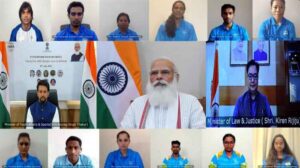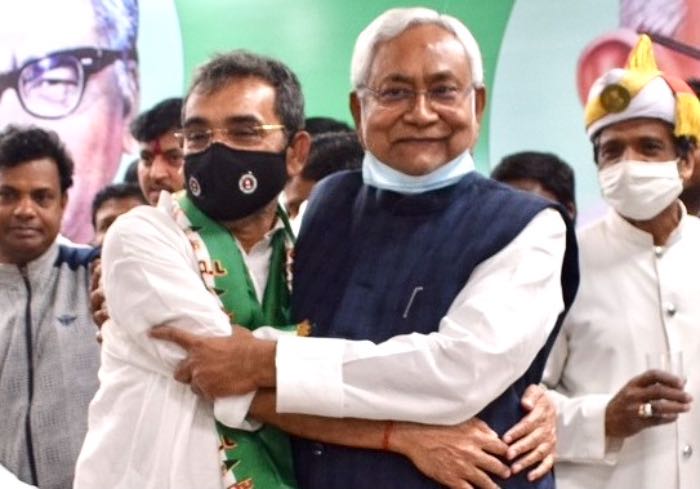US Congressman William Lacy Clay famously said this about politics, “This is quite a game, politics. There are no permanent enemies, and no permanent friends, only permanent interests.” The most interesting thing about this statement is that it is all-encompassing. What is true for America is true for Bihar as well. And so, it was not really surprising to see Nitish Kumar embracing Upendra Kushwaha once again. It’s a political merry-go-round on display. In the past, they have been friends-foes-friends-foes and this is the third time that Nitish and Kushwaha have been witnessed locked in ‘bromance’.
The moot question is what has brought them together? What made them swallow their pride to bury their hatchets? And what do they aim to achieve together?
The two-word answer to these questions is ‘political survival’.
Nitish Kumar is called the ‘Chanakya’ of Bihar politics and being a trained engineer he is also a wizard of permutations and combinations theory. But currently, he is facing one of the most challenging phases of his political career, even though he continues to be the Chief Minister of the state. That’s because his chips are down and he is a junior partner in the ruling coalition, with just 43 MLAs in his party as against 74 in the BJP.
Someone who quit the NDA refusing to share the dais with Narendra Modi, and double-backed later to hold on to his chair, had not imagined that the voters would cut him down to size in the 2020 assembly elections. Someone who emerged as an alternative to the politics of Lalu Prasad on the strength of a viable alliance, and later switched over to stay in power, had not contemplated that his meticulous calculation would go wrong.
Now Nitish Kumar has come to realise that he needed to resurrect his standing for his political future, and so he is cobbling together a formidable formula to restore his pole position.
Nitish Kumar and Upendra Kushwaha assume that together they are the ‘Luv-Kush’ of Bihar. According to popular belief, Lord Ram’s sons Luv and Kush are considered ancestors of Nitish’s Kurmi and Kushwaha’s Koiri castes. Together these two castes constitute around 8-10% of the Bihar voters, which is close to 14% of Yadav voters, the core base of RJD, in the state.
Consequently, on March 14, the supposed political representatives of the two significant social forces came together with Kushwaha announcing to merge his Rashtriya Lok Samata Party (RLSP) with the JD(U), in return Nitish Kumar made him the chairman of the parliamentary board of the party.
Ironically, just two days ago, as many as 41 functionaries of the RLSP had joined the Rashtriya Janata Dal (RJD). Mocking the RLSP chief then, Tejashwi Yadav had said, “Only Upendra Kushwaha is left to survive or sink in the RLSP.”
Upendra Kushwaha, indeed, had been facing an existential crisis after he failed to clinch even a single seat in the 2019 general elections and 2020 assembly elections. Though he succeeded in hurting the JD(U)’s winnability, limiting the party to 43 seats in the state polls, securing the crucial ‘Koiri’ votes at several seats, who not only outnumber the ‘Kurmis’ but are also spread across the state while Nitish’s caste is primarily concentrated around the Magadh region.
Nitish Kumar and Upendra Kushwaha may have been bitterly critical of each other during the elections, but the mandate of the people has forced them to reconcile for their political relevance. With Kushwaha on his side again, Nitish can hope to regain the lost political ground and become a force to reckon with. Something he desperately needed after the Bihar elections.
In the politics of symbolism, the position of strength always matters, but Nitish Kumar no longer holds the key to the Bihar government despite being sworn-in as the Chief Minister. The BJP, being the big brother in the alliance, has been calling the shots in the state, be it securing the post of the assembly speaker for the party or delaying the expansion of the state cabinet, to mention a few of them.
What could be normal for a government of alliance, may not be going down well with once-a-boss Nitish Kumar. And the opposition has been rubbing salt into the wound by calling him the weakest Chief Minister in India.
So the Bihar Chief Minister has been reaching out to all and sundry in the political circle to bolster his position in the state. In January, he met all five elected MLAs of AIMIM at his residence and recently hinted that Assaduddin Owaisi’s party could be on the verge of a breakup leaving the AIMIM Chief all alone.
Nitish Kumar must be upbeat now that Upendra Kushwaha’s re-entry into JD(U) has added muscles to his political entity in Bihar. But the only snag in this bromance is that ‘Kush’ is no less ambitious than ‘Luv’ and nurtures a desire to become the Chief Minister himself. Today, he might have surrendered his political ambition to his friend, but tomorrow, when the going is good again, he may not think twice before turning a foe, repeating the alienation of the 2009 and 2013.









Will Amarinder Singh prove BSY for BJP in Punjab?
Afghanistan crisis: Subjugation of a nation and the Taliban rule
Two-child policy: BJP’s masterstroke before elections in UP?